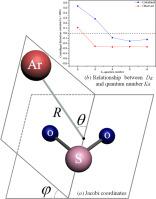SO2 ν3区Ar-SO2配合物的高分辨率红外光谱:旋转振动光谱的全局分析
IF 1.9
3区 物理与天体物理
Q2 OPTICS
Journal of Quantitative Spectroscopy & Radiative Transfer
Pub Date : 2025-09-16
DOI:10.1016/j.jqsrt.2025.109681
引用次数: 0
摘要
本文对Ar-SO2范德华配合物的红外光谱和分子间势能面分别进行了实验和理论研究。首先,利用外腔量子级联激光光谱仪记录了SO2的γ - 3不对称拉伸区Ar-SO2配合物在超音速缝缝射流膨胀中的红外光谱,共观测到429个跃迁。对这些新观测到的跃迁,以及先前报道的微波和SO2单体v1激发态的光谱数据进行了全面分析,使用了沃森A-还原的不对称转子哈密顿量。精确地确定了两个隧道分量的谱带原点分别为1361.33300(21)和1361.30097(18)cm-1。与SO2单体ν3波段的振动频率相比,这些值表示大约0.7 cm-1的蓝移。测定了Ar-SO2在SO2单体v3激发态下的隧穿分裂为960.0 (58)MHz,分别比在SO2单体v1激发态和基振态下低22.3和103.4 MHz。在CCSD(T)/aug-cc-pVTZ能级上构建了三维分子间势能面,并补充了键函数,确定了全局最小值为结构参数R = 3.59 Å, θ = 102.0°,φ = 90.0°的非平面Cs几何形状。四次离心畸变常数DK的符号强烈依赖于不同Ka量子数的跃迁,这一结论得到了实验观测和理论计算的良好吻合。本文章由计算机程序翻译,如有差异,请以英文原文为准。

High-resolution infrared spectra of the Ar–SO2 complex in the ν3 region of SO2: A global analysis of rovibrational spectra
In this work, infrared spectra and intermolecular potential energy surface of the Ar–SO2 van der Waals complex are investigated experimentally and theoretically, respectively. Firstly, the infrared spectrum of the Ar–SO2 complex in the ν3 asymmetric stretching region of SO2 is recorded using an external-cavity quantum cascade laser spectrometer in a supersonic slit jet expansion, and a total of 429 transitions are observed and assigned. A global analysis of these newly observed transitions, together with previously reported spectroscopic data of the microwave and SO2 monomer v1 excited state, is carried out using a Watson A-reduced asymmetric rotor Hamiltonian. The band origins of the spectra are accurately determined to be 1361.33300(21) and 1361.30097(18) cm–1 for the two tunneling components, respectively. These values represent a blue shift of approximately 0.7 cm–1 compared to the vibrational frequency of the SO2 monomer ν3 band. The tunneling splitting of Ar–SO2 in the SO2 monomer v3 excited state is determined to be 960.0 (58) MHz, which is 22.3 and 103.4 MHz lower than that observed in the ground vibrational state and in the SO2 monomer v1 excited state, respectively. Furthermore, a three-dimensional intermolecular potential energy surface is constructed at the CCSD(T)/aug-cc-pVTZ level supplemented with bond functions, and the global minimum is determined to be a non-planar Cs geometry with structural parameters R = 3.59 Å, θ = 102.0°, and φ = 90.0°, respectively. What is more, the sign of the quartic centrifugal distortion constant DK is found to strongly depend on transitions with different Ka quantum numbers, and this conclusion is supported by the good agreement between experimental observations and theoretical calculations.
求助全文
通过发布文献求助,成功后即可免费获取论文全文。
去求助
来源期刊
CiteScore
5.30
自引率
21.70%
发文量
273
审稿时长
58 days
期刊介绍:
Papers with the following subject areas are suitable for publication in the Journal of Quantitative Spectroscopy and Radiative Transfer:
- Theoretical and experimental aspects of the spectra of atoms, molecules, ions, and plasmas.
- Spectral lineshape studies including models and computational algorithms.
- Atmospheric spectroscopy.
- Theoretical and experimental aspects of light scattering.
- Application of light scattering in particle characterization and remote sensing.
- Application of light scattering in biological sciences and medicine.
- Radiative transfer in absorbing, emitting, and scattering media.
- Radiative transfer in stochastic media.

 求助内容:
求助内容: 应助结果提醒方式:
应助结果提醒方式:


